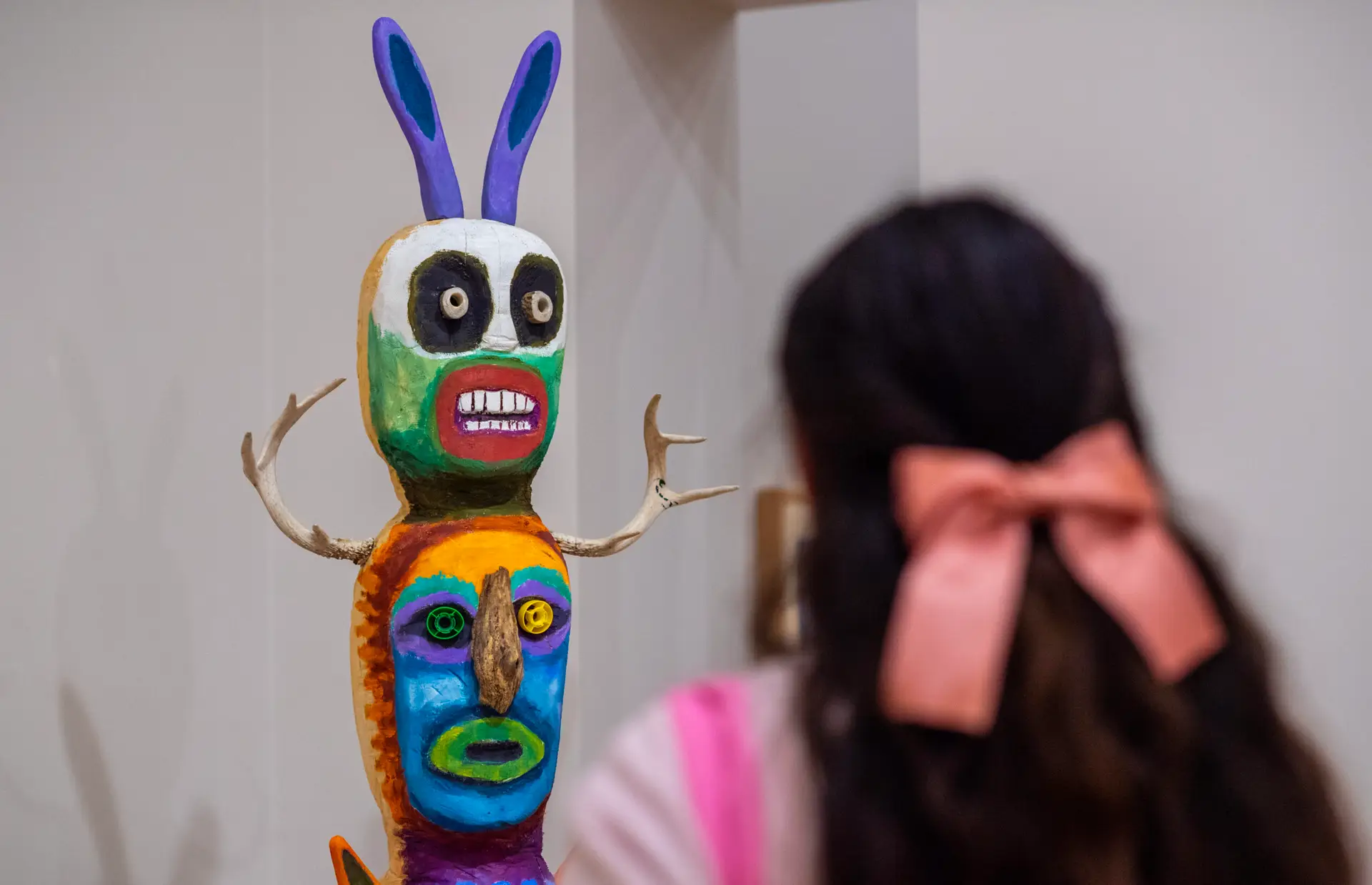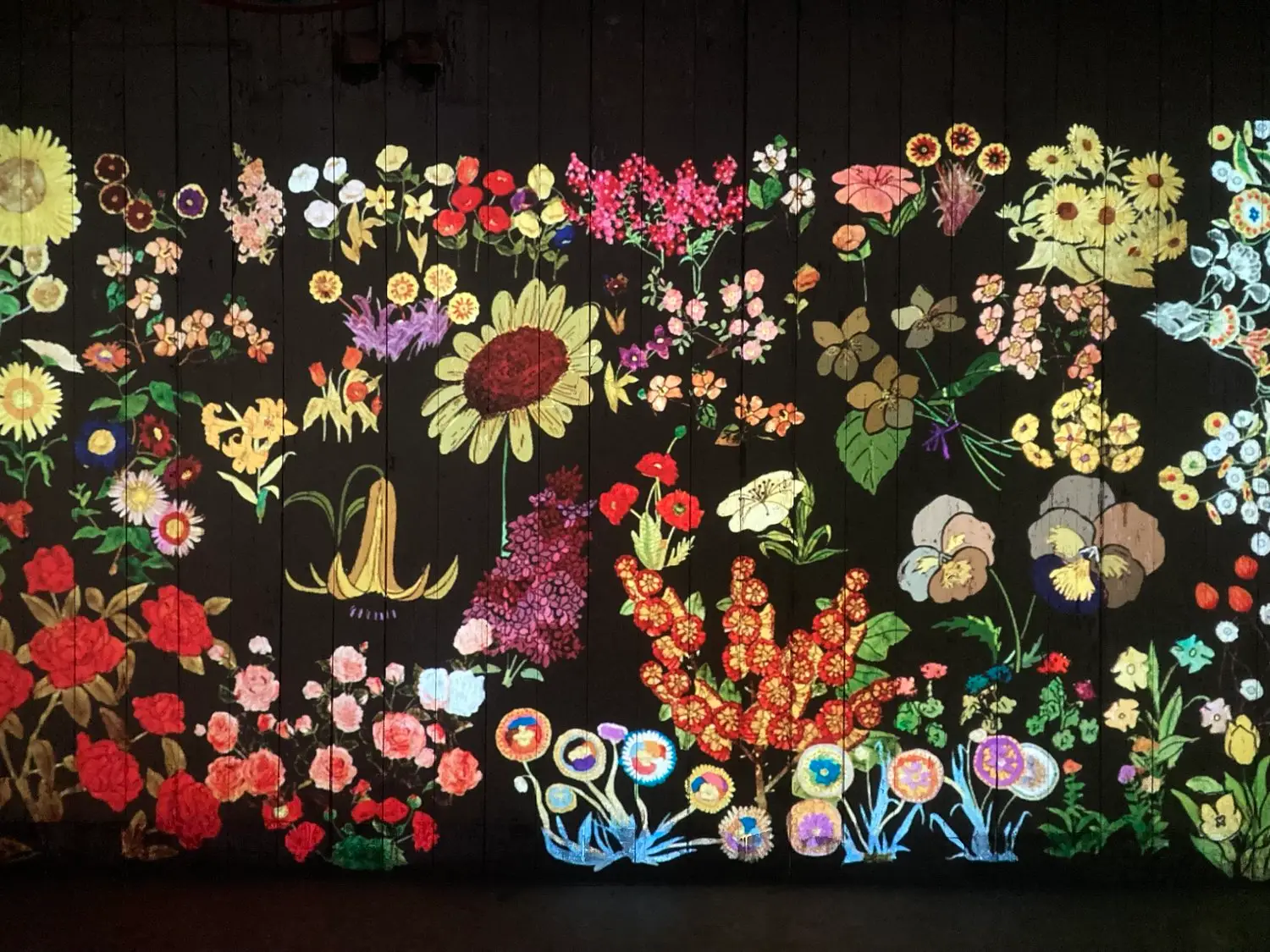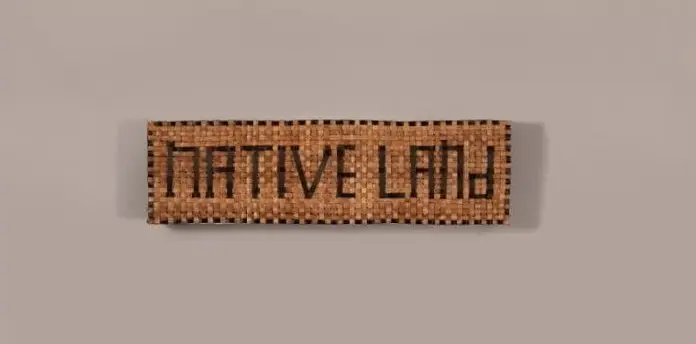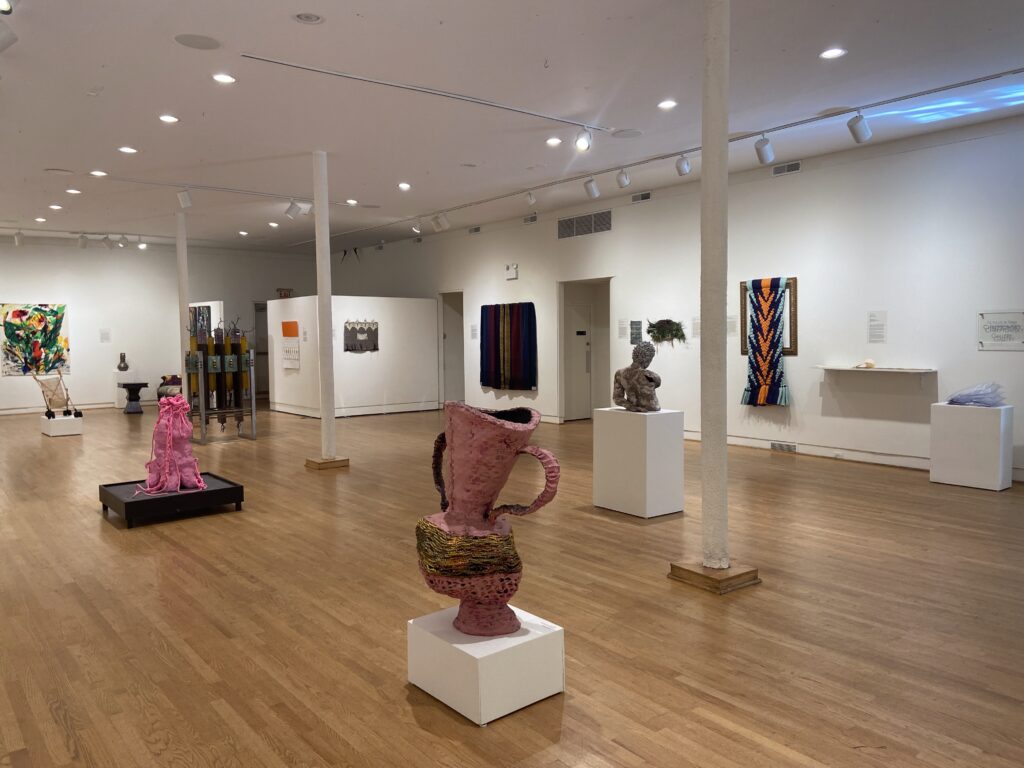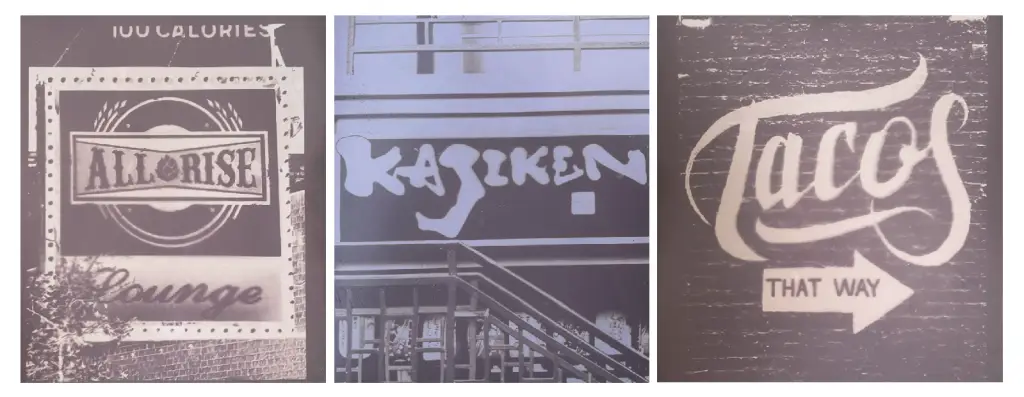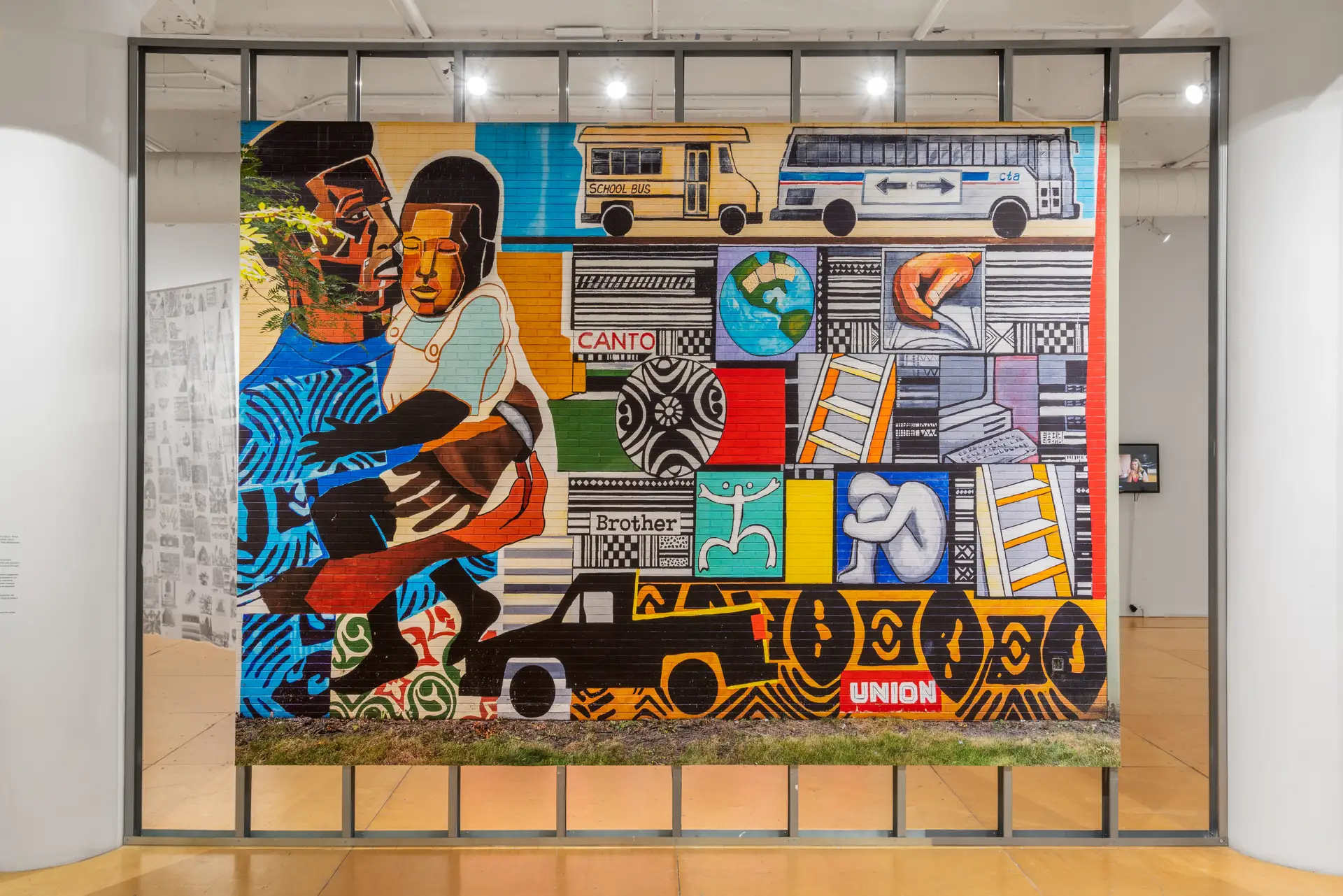“I’m not working for the institution. I work for the community. That’s the heart of my job”—Teagan Harris, Terra Foundation Engagement Fellow, The Block Museum of Art
Museums, as institutions, have long functioned as colonial constructs—sites where objects, histories, and identities are classified, displayed, and disciplined. Frantz Omar Fanon’s seminal critique of colonial infrastructure provides a powerful framework for understanding the artificiality of these spaces. In The Wretched of the Earth, Fanon explores how colonial regimes construct physical and ideological landscapes that impose order, dictate knowledge, and reinforce hierarchies of power. Museums, in this sense, function as extensions of these regimes, embedding a colonial gaze that controls how history is seen, who is authorized to tell it, and who is excluded from the narrative.
As built spaces, carefully designed to shape perception, dictate engagement, and construct narratives about whose histories matter and how they are presented, museums bring with them an element of manufactured realness and neutrality. Teagan Harris, who serves as The Block Museum of Art’s Terra Foundation Engagement Fellow, is keenly aware of this reality. Through her work, she has navigated the tensions between institutional frameworks and community needs, making space for engagement that is not just representational but actively reciprocal.
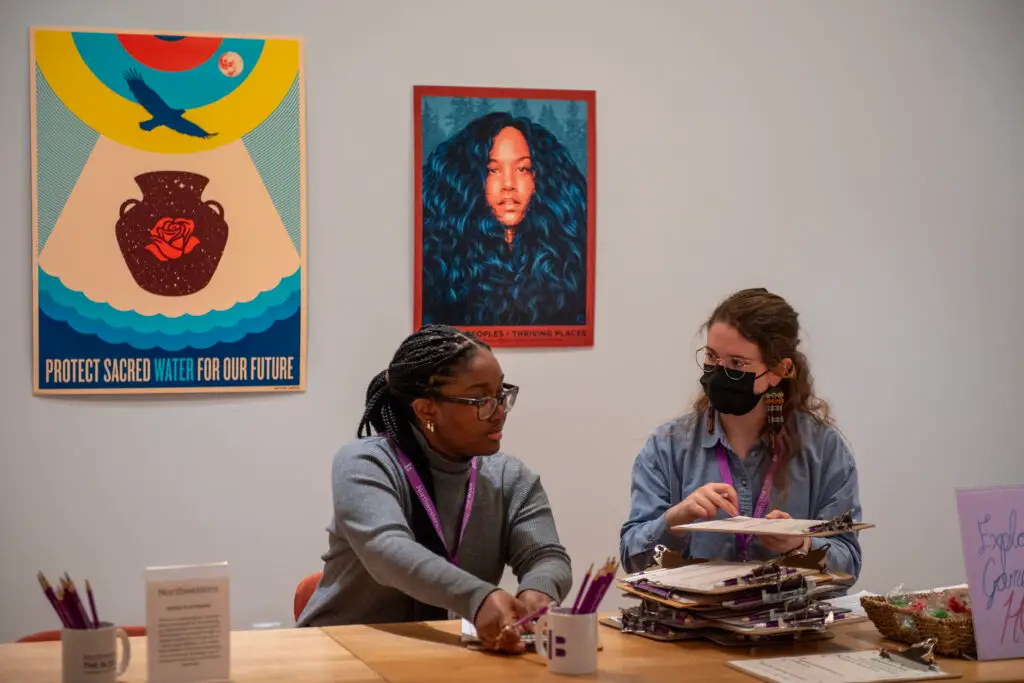
Teagan Harris (right), Terra Foundation Engagement Fellow, with a colleague in The Block Museum of Art’s exhibition, Woven Being: Art for Zhegagoynak/Chicagoland. Photo by Holly Trevan.
Harris’s most recent work involves joining the team leading the curation of The Block Museum of Art’s Woven Being: Art for Zhegagoynak/Chicagoland exhibition. Guest curator Jordan Poorman Crocker, in collaboration with The Block Museum curator Kathleen Bickford Berzock and former Block curator Janet Dees, worked with four Indigenous artists—Andrea Carlson (Grand Portage Ojibwe/European descent), Kelly Church (Match-E-Be-Nash-She-Wish Tribe of Pottawatomi/Ottawa), Nora Moore Lloyd (Lac Courte Oreilles Band of Lake Superior Ojibwe), and Jason Wesaw (Pokagon Band of Potawatomi)—on an exhibition that focuses on the historical and cultural representations of Zhegagoynak, the place now known as Chicagoland. The exhibition highlights the artistic practices and perspectives of these four artists through the presentation of works of 33 Native American artists from the Chicago region. Through a diverse range of artworks, including textile-based art, multimedia, and interactive installations, Woven Being addresses the vital role of Indigenous knowledge systems and challenges traditional, often colonial, narratives of art history. The exhibition provides an opportunity for Indigenous communities to engage in collective storytelling and reframe their presence within the cultural and political landscape of the region. The Block Museum, located at Northwestern University’s campus in Evanston, Illinois, is situated on the land of the Council of Three Fires, which includes the Ojibwe, Odawa, and Potawatomi peoples, Indigenous nations to whom the land historically belonged. The Ho-Chunk, Miami, Menominee, Sac, Kickapoo and Fox nations are among other tribes that inhabited the broader Illinois area around Northwestern University.
Artificial Landscapes: Manufactured Environments of Power in Museums
Colonial structures like museums do not just shape space—they shape the consciousness of those who move through them. The artificiality of museum spaces is not merely an aesthetic concern but a fundamental act of power. Museums are curated landscapes of control, sites where objects and stories are framed not simply for education but for the reinforcement of Western knowledge systems. Every object placement, every wall text, every pathway through a gallery is intentional, often designed and meticulously structured to shape visitor engagement.
“Every museum you go into, someone thought about each placement of an object and how it would affect the average user’s experience,” Harris explains. “The question is, who is the average user?” This question became particularly pressing in Woven Being, which aims to foreground Indigenous perspectives within a predominantly Eurocentric institutional setting. Harris describes the paradox of curating Indigenous narratives in a space not built for Indigenous audiences. “How do we center an audience that’s different from others we’ve seen come through Northwestern?” she asks. “How do we acknowledge and make up for historical wrongs?”
Harris’s concerns connect to a long-standing intellectual tradition that interrogates the role of cultural institutions in perpetuating colonial power structures. Fanon’s critique pushes us to challenge the notion that museums are neutral custodians of history and instead view them as active agents in the production of colonial knowledge, enforcing Western frameworks that define what is preserved, how it is framed, and who is allowed to participate in its interpretation. This is evident in how museums classify and display Indigenous art. Objects that exist within living traditions, embedded in community contexts, are removed from those worlds and re-situated within institutional categories of “art” or “artifact.”
One of the most striking moments exemplifying this tension occurred for Harris when artist Monica Rickert-Bolter carried her painting through the museum doors, fully in possession of her work—until she stepped inside the museum. “Before she made it through the doors, it was just Monica with a painting. The second she made it in, it was gloves, special cushions… Suddenly, it became art.” This transition, from the realm of lived creation to the hyper-mediated space of institutional legitimacy, underscores the artificiality of the museum space itself. Outside, it was a piece of her own making; inside, it became institutional property, requiring gloves, conservation materials, and curatorial framing. This transformation led to the artist’s work existing within a system that fundamentally alters its relationship to the world.
Rethinking Engagement: Challenging the Institutional Gaze Through Woven Being
Despite structural limitations, Woven Being actively seeks to subvert institutional norms. Unlike exhibitions that privilege detached, visual consumption, this project incorporates sensory engagement—a direct challenge to the traditional makeup of museums. Rather than relying singularly on visual engagement, visitors are drawn in through sensory and interactive elements, challenging the notion of museums as places of passive observation. “Woven Being actually does overcome some of the small barriers that exist in museums that were a little easier to build in. For instance, you can smell the sweetgrass of one of the installations when you walk in, which is something you don’t find in museums, you’re not usually going to find a lot of living objects or recently living objects. That’s not something you tend to find in museums,” Harris notes. The scent of sweetgrass, the interactive installations, the tactile engagement all work to unsettle the traditional ways in which museums demand passive observation.
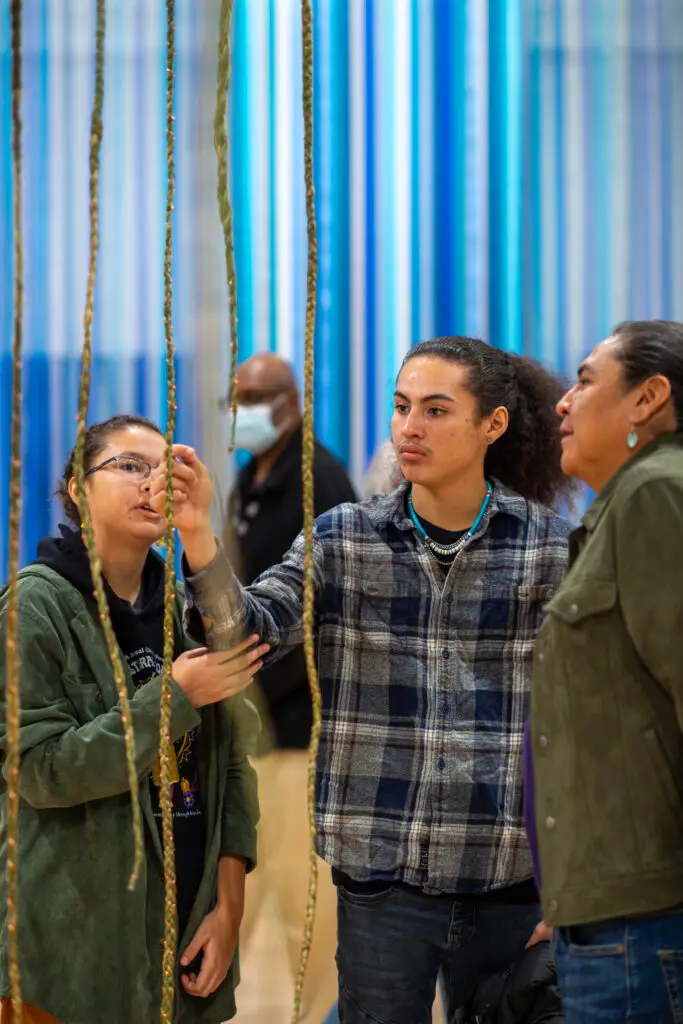
Visitors at the opening of Woven Being: Art for Zhegagoynak/Chicagoland at The Block Museum of Art. Photo by Holly Trevan.
At the heart of the exhibition’s engagement strategy is the Community Room, a space Harris helped develop as an alternative to the rigid formalism of the gallery. Instead of dictating how visitors should interact, the room invites them to engage on their own terms. Harris describes it as a living room, where people can move furniture, start conversations, and see themselves reflected in ways that traditional museum spaces rarely allow. “You walk into your friend’s house and grab something off their wall. That’s the atmosphere we wanted—a space where people are not just passive viewers but actively engaging,” explained Harris.
Designed with multigenerational participation in mind, particularly for children and families whose behavior is often regulated in mausoleum-like museums, the room includes puzzles, games, and books, rejecting the notion that museums are spaces for silent engagement. The Forum Wall further challenges this by turning the exhibition into a dialogue. Visitors are encouraged to answer the same reflective questions about belonging posed to the artists, creating a layered conversation between art, audience, and institution. “We have had so many fun answers—kids drawing pictures, people reflecting on personal histories… Even though visitors never meet, they are engaging in a shared conversation.”
For Harris, true engagement is not about programming that draws in numbers but about creating conditions for presence and relationship-building. One of her key initiatives has been the introduction of drop-in hours at the Community Room, a move away from the high-barrier formality of scheduled events. “It’s like having a community center inside a museum—somewhere you know you can come at a set time every month, just to be, talk, or engage however you feel comfortable.”
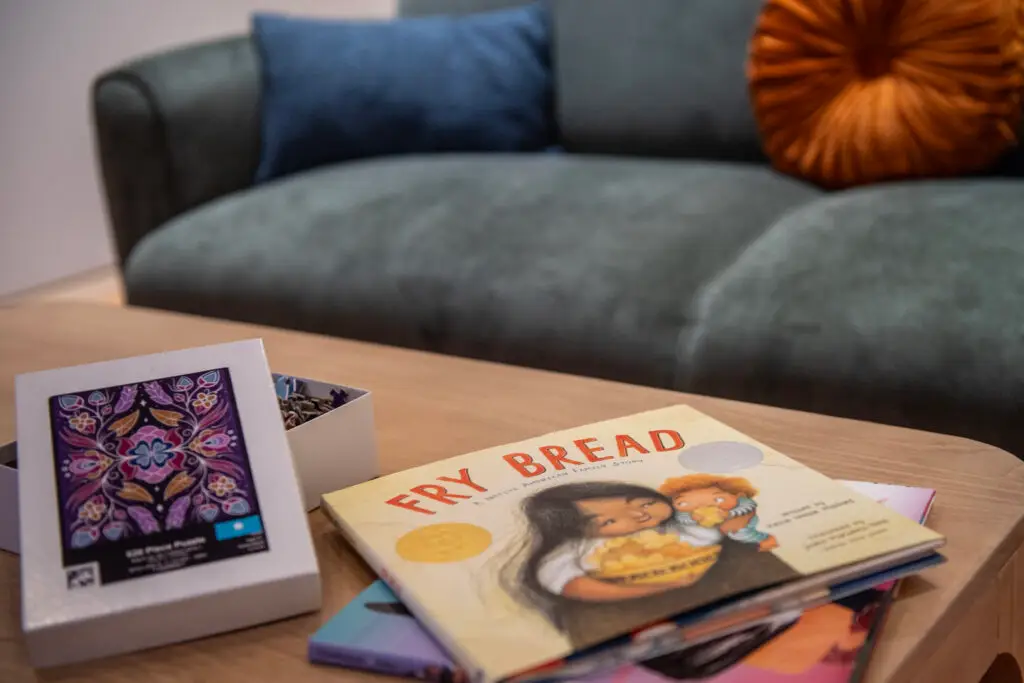
Woven Being Community Room. Photo by Holly Trevan.
This shift toward a sustained, rather than event-based, approach to engagement acknowledges that museum attendance is not just about what is on display but about who feels invited into the space and how they are allowed to exist within it.
This space has proven to be one of the exhibition’s most significant successes. Unlike many museum programs that struggle to bring in intergenerational audiences, Woven Being has drawn families, students, and community members in significant numbers. The exhibition’s ability to generate authentic participation signals the necessity of such spaces—they are not mere accessories to institutional programming but essential sites of engagement that museums must sustain long-term.
While Harris’s work is an inspiring example of how exhibitions can create meaningful engagement, it also highlights the fragility of institutional commitments. Museums and educational institutions have a long history of temporary gestures – of welcoming marginalized narratives for a moment before reverting to old ways. Fanon warns us that colonial institutions are not designed to dismantle themselves; rather, they adapt, absorbing critique without fundamentally altering their structures.
This raises critical questions: Can museums commit to sustained transformation, or will exhibitions like Woven Being remain exceptional rather than foundational? Institutions cannot afford to treat this work as a one-time engagement with “diverse audiences.” Instead, they must ask: What does it mean to sustain this engagement beyond a single exhibition? How do institutions make real commitments to institutional accountability, reparative justice, and long-term change?
Drawing Boundaries: Community Engagement and Museum Practice
Reflecting on her time as a Terra Foundation Engagement Fellow, Harris emphasizes that her work has never been about serving an institution—it has always been about serving the community. “I’m not working for the institution. I work for the community. That’s the heart of my job,” she states, a sentiment that underscores her entire approach to engagement.
For Harris, true community engagement is not about inviting people into institutional spaces on predetermined terms—it is about creating spaces where their voices actively shape the narrative. Her role is not simply to facilitate dialogue but to ensure that it extends beyond institutional walls; this includes things from fostering artist-led initiatives to centering local needs in programming decisions. For Harris, it is important that the work resonate with the Native community, that it allows them tangible access to benefits museums provide, and that it brings the folks at the museum into a real relationship with their neighboring community. Harris’s hope is that the influence of this show and its programming will change the relationship between the museum and its community, fostering ongoing partnership not just accountability. As she reflects on her work, Harris remains steadfast in her belief that institutions must prioritize the needs of the communities they claim to serve. “At the end of the day,” she says, “I’m here to ensure that the community gets what they need, not what the institution thinks it should offer.”
The success of Woven Being–its ability to bring in new audiences, foster intergenerational engagement, and open up dialogue about institutional responsibility–is a testament to the impact that exhibitions can have when they are designed with care and intention. The necessity of institutional transformation does not mean that the work happening within these spaces is unimportant. However, as Fanon emphasized in The Wretched of the Earth, decolonial efforts cannot be confined to sporadic acts; they must be continuous and systemic, challenging the very power structures that sustain colonial institutions. This is why the work of museums must transcend one-time exhibitions or token diversity programs, particularly with Indigenous communities. It is not enough to invite marginalized voices into the space; these voices must be allowed to reshape the narrative, redefine cultural representation, and reframe how knowledge is produced within these institutions.
Exhibitions like Woven Being at Northwestern’s Block Museum show what is possible when institutions decide to make genuine efforts, but it is ultimately up to these same institutions to decide whether such moments are isolated gestures or the foundation for sustained transformation. If museums are to remain relevant, they must move beyond the cycle of temporary inclusion toward a structural reckoning—one that doesn’t just check boxes but addresses the very systems of control that have long been embedded in their operations. The question is not whether museums can create space for marginalized narratives—but whether they are willing to relinquish their control over how those narratives are told, and whether they will sustain the changes necessary to make that a reality.
Woven Being: Art for Zhegagoynak/Chicagoland is on view at The Block Museum of Art through July 13, 2025.
ABOUT THE AUTHOR

Fariha Koshul
Fariha Koshul, a Chicago-based writer for Terra Foundation for American Art, combines her academic training in ethics, anthropology and sociology with practical experience in digital curation, collections management and archiving. Her time at the University of Chicago involved leading research projects and collections care aimed at incorporating ethical practices in diverse cultural contexts. Fariha’s work is marked by a deep commitment to an understanding of the ethical implications of working with anthropological material, specifically in curatorial and museum spaces, and to the promotion and preservation of cultural, artistic and faith-based narratives and communal and social histories.


